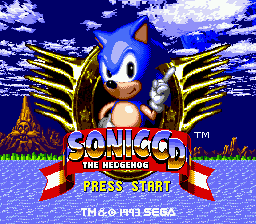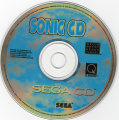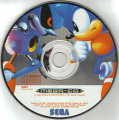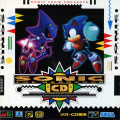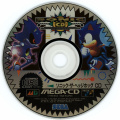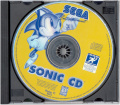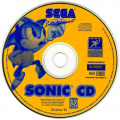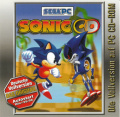Sonic the Hedgehog CD
From Sonic Retro
| Sonic the Hedgehog CD |
|---|
| System(s): Sega Mega CD, Windows PC |
| Publisher: Sega |
| Developer: Sega |
| Genre: 2D Platform |
Sonic the Hedgehog CD or Sonic CD (as it is known in Europe and North America) is a video game that is still well acclaimed by Sonic fans. Yuji Naka never took part in its development, but instead was handled by Sonic creator Naoto Ohshima. This explains why the theme of the game is different from other Sonic games.
Sonic CD was the first Sonic game to use a backup save, using the internal Sega CD memory or a backup RAM cartridge. The game saves after the end of each third zone and records the best times of the player in the time attack mode.
It turns out that Amy Rose, a female hedgehog, had used tarot cards to find Sonic, but was kidnapped in front of his very eyes. Sonic must must find Metal Sonic, whom kidnapped a girl named Amy Rose. Meanwhile, he must also collect the Time Stones and travel through time to foil Dr. Robotnik's latest plot.
Contents
Gameplay
The game's physics have Sonic feeling generally more sluggish than normal. His Spin Dash in Sonic CD is different than that of Sonic 2's; the position he takes in both games is different. A new move was added to complement the Spin Dash: the Super Peel-Out. The Super Peel-Out can be performed by pressing ![]() and any trigger button. This causes Sonic to rev in position until
and any trigger button. This causes Sonic to rev in position until ![]() is released, sending Sonic speeding off. The difference between Sonic's Spin Dash and his Super Peel-Out is that spin dash damages enemies who get in his way due to his curled attacking pose, while the Super Peel-Out leaves Sonic vulnerable to attack but is faster.
is released, sending Sonic speeding off. The difference between Sonic's Spin Dash and his Super Peel-Out is that spin dash damages enemies who get in his way due to his curled attacking pose, while the Super Peel-Out leaves Sonic vulnerable to attack but is faster.
Time Travel
The game's key element is the concept of time travel. The player can travel to four different versions of each level in three different time periods. This is accomplished by passing "Past" or "Future" speed posts scattered around the level and then running at top speed until the time period changes. There are never any "Past" signs in the past and never any "Future" signs in the future. If the player is able to destroy a special machine in the past, then they travel to a "Good Future" with no enemies.
The different time zones have slightly different layouts and sprite placements, as well as significant changes in the level music, art and palette. In addition, the robots within a level fall into a state of disrepair as time passes; in the present, some machines have become worn down while in the future all of them have. This affects the speed and attacking ability of the robots; some of them become completely ineffective, while others do not significantly change.
The appearance of the future changes depending on what is accomplished in past. If the levels robot generating machine is destroyed or all seven time stones are already collected, all of Dr. Robotnik's robots will be destroyed in the past. The future will also be the a "Good Future" and there will be no enemies and fewer hazards. If the machine is not destroyed, then warping to the future will lead to a "Bad Future" in which Dr. Robotnik's robots are still present, there will be more hazards (though not always as many as in the past), the palette will be darker.
In addition to the robot generating machine, hidden within the past of each level is a machine which projects a hologram of Metal Sonic squashing one of that particular zone's animals underfoot. Destroying this machine causes animals to appear in the past and present levels. However the animals are always present in the Good Future, regardless of whether or not this machine was destroyed.
The third zone always takes place in the future and is mainly a short run up to the boss. Most boss battles are more elaborate than those in the other Sonic games, and typically require fewer hits than the usual 6 or 8. These boss battles, however, require more effort to actually hit Robotnik; one battle takes place on a makeshift pinball table and requires the player to use flippers to get up to Robotnik. Two battles do not involve hitting Robotnik to damage him; one takes place on a giant treadmill where the objective is to wear out Robotnik's machine by running on it, and the other is a race against Metal Sonic.
The good ending to the game can be reached by completing all the good futures or by collecting the 7 Time Stones in the Special Stages.
Development
After the release of Sonic the Hedgehog, creator Yuji Naka had grown dissatisfied with the rigid corporate policies at Sega. Naka moved to America to work with the Sega Technical Institute. Incidentally, a large number of the original design team of Sonic also left for America to help instructing the American developers. With half of Sonic Team and two of its most important creators present, the Sega Technical Institute eventually got the job of developing Sonic the Hedgehog 2.
Meanwhile, in Japan, Sonic CD was handled by a separate development team, headed by Sonic creator Naoto Ohshima. As both Sonic CD and Sonic 2 were developed independently from each other, each game took a different direction from Sonic 1. The gameplay of Sonic 2 would eventually be favored for future games, but this explains why the theme and handling of Sonic CD differs so much from the rest of the series. However, Sonic CD still included elements from Sonic 1, such as identical Sonic sprites, and would influence later games with its pseudo-3D art, as seen in the Knuckles' Chaotix title screen.
Sonic CD was released after Sonic the Hedgehog 2 but before Sonic the Hedgehog 3. However, since Sonic 3 takes place where Sonic 2 left off, some fans believe the story of Sonic CD either takes place before Sonic 2 or after Sonic & Knuckles.
The US Version
The most controversial fact about this game is that the US and Japanese versions feature two different soundtracks. Europe uses the Japanese soundtrack. The Japanese soundtrack was composed by Naofumi Hataya and Masafumi Ogata, and featured songs by Keiko Utoku. The songs were entitled "Sonic - You Can Do Anything" (infamously nicknamed "Toot Toot Sonic Warrior" by Sonic fans) and "Cosmic Eternity".
The US version was delayed a few months to have a new soundtrack composed by Spencer Nilsen, who did other Sega CD soundtracks as well as some early Sega Saturn soundtracks. All the music (save for the Past tunes, which were in PCM audio rather than Red Book CD Audio) was replaced, and new themes were composed, cancelling the similar rhythms and beats with the Present, Good Future, and Bad Future media. The rhythm continuation can only be heard in the PAL Version, while the NTSC version has its own rhythm similarities. The new theme was "Sonic Boom", performed by Pastiche. Both the opening and ending had similar lyrics but different instrumentation. Every re-release of the game in the US exclusively has this soundtrack, including both the PC version and the one in Sonic Gems Collection (the latter having the American soundtrack even in Europe); the Japanese soundtrack surfaced in Sonic Screensaver, but otherwise has never made it to the States.
Sonic fans are usually split between the music of each game. Some prefer Hataya and Ogata's music, others prefer Nilsen's music, and some like both equally.
The US version also replaced Amy Rose's name in the manual with that of Princess Sally to garner support for the television show, despite the fact that the Princess Sally character was already established.
Ports
A version available for the personal computer was released in Japan on August 9, 1996, with a North American version in August 26, 1996, and a European version in October 3, 1996. Among the most noteworthy changes of this version was the fact that the entire FMV anime intro and ending sequence were available for this version. The Mega-CD version only had a truncated version of the intro and ending sequence. The Japanese version of the game had its manual translated from the US version, and all versions had the US soundtrack, with the "Past" tunes converted to normal CD tracks. Also on the disc is a short video clip of a pencil sketch of Sonic in action. Unfortunately, the PC version is not compatible with Windows XP or Windows Vista without the use of a homebrewed patch created by Korama ([1]).
In addition to the PC port, a modified version of it is part of the Nintendo GameCube (and, in Japan and Europe, PlayStation 2) compilation Sonic Gems Collection. The soundtrack in this version depends on the console region. Europe consoles use the American soundtrack instead of Japanese one, however. A bug in emulation surfaced in Sonic Gems Collection. Water in Tidal Tempest appears clear instead of green (as it does in the Sega CD version), possibly related to the Windows compatibility problems.
Manuals
- Sonic CD US Manual
- Sonic CD JP Manual
- Sonic CD EU Manual
- Sonic CD (PC) US Manual
- Sonic CD (PC) JP Manual
Prototypes
Three Sonic CD prototypes have been recovered to date:
Also Released On
- Sonic Gems Collection for the Nintendo GameCube and Sony Playstation 2 (2005)
Production Credits
Executive Producer: Hayao Nakayama
Producers: Minoru Kanari, Makoto Oshitani
Director: Naoto Oshima
Program Director: Keiichi Yamamoto
Art Director: Hiroyuki Kawaguchi
Sound Director: Yukifumi Makino
Game Designers: Hiroaki Chino, Kenichi Ono, Yuichiro Yokoyama, Takao Miyoshi, Akira Nishino
Character Designer: Kazuyuki Hoshino
Landscape Designers: Hiroyuki Kawaguchi, Takumi Miyake, Masahiro Sanpei, Masato Nishimura, Hideaki Kurata
Special Stage Designers: Kazuyuki Hoshino, Judy Totoya
Special Stage Progammer: Keiichi Yamamoto
Animation Programmers: Yuichiro Mine, Eiji Horita
Animation Visual Directors: Hiroyuki Kawaguchi, Masahiro Sanpei
Visual Design: Kazuyuki Hoshino, Takumi Miyake
Chief Programmer: Matsuhide Mizoguchi
Programmers: Yuichi Matsuoka, Hiroshi Takei, Tatsuya Satoh, Noritaka Yakita
Sound Effects: Yukifumi Makino
Sound Programmer: Yukifumi Makino
Music (Original/JPN): Naofumi Hataya and Masafumi Ogata
Music (US): Spencer Nilsen, David Young
Special Thanks: Naofumi Hataya, Masafumi Ogata, Daisuke Saito, Hiroshi Kubota, Reiko Kodama, Yoshiaki Kashima, Takenobu Mitsuyoshi, Masaru Setsumaru, Hifiri Aoki, Stene Ray Burton, James Michael Spahn, Kounosuke Yoshio, Tomoko Saskai, Aki Kamta, Masato Nishimura, Fujio Minegishi, Jina Ishiwatari, Katsufumi Yoshimori, Tetsuo Akagi
, Kaeko Itoh, Hiromi Nakatani, Hiroshi Fukuda, Etsuko Yamada, Ryuichiro Kutsuzawa, Takashi Lwade, Michiazu Tamamura, Masumi Uchida, Toru Watanuki, Makiko Suzuki, Audix, Digital Support Group, Fairlight E.S.P, Opcode, Otari, Zoom
Resources
Original Sound Version Recordings
For the Windows version see Sonic_CD_for_Windows_95_OST for a download page. For the Japanese Sega CD version see Sonic CD (Japan & PAL Regions) OST.
Artwork
Scans
Sega CD
PC
- SCDPC-disc.jpg
UK PC disc
| Sonic the Hedgehog games for the following systems | |
|---|---|
| |
1991 Sonic the Hedgehog | Sonic Eraser 1992 Sonic the Hedgehog 2 1993 Sonic the Hedgehog CD | Dr. Robotnik's Mean Bean Machine | Sonic Spinball 1994 Sonic the Hedgehog 3 | Sonic & Knuckles 1995 Chaotix | Sonic Classics 1996 Sonic 3D: Flickies' Island |
